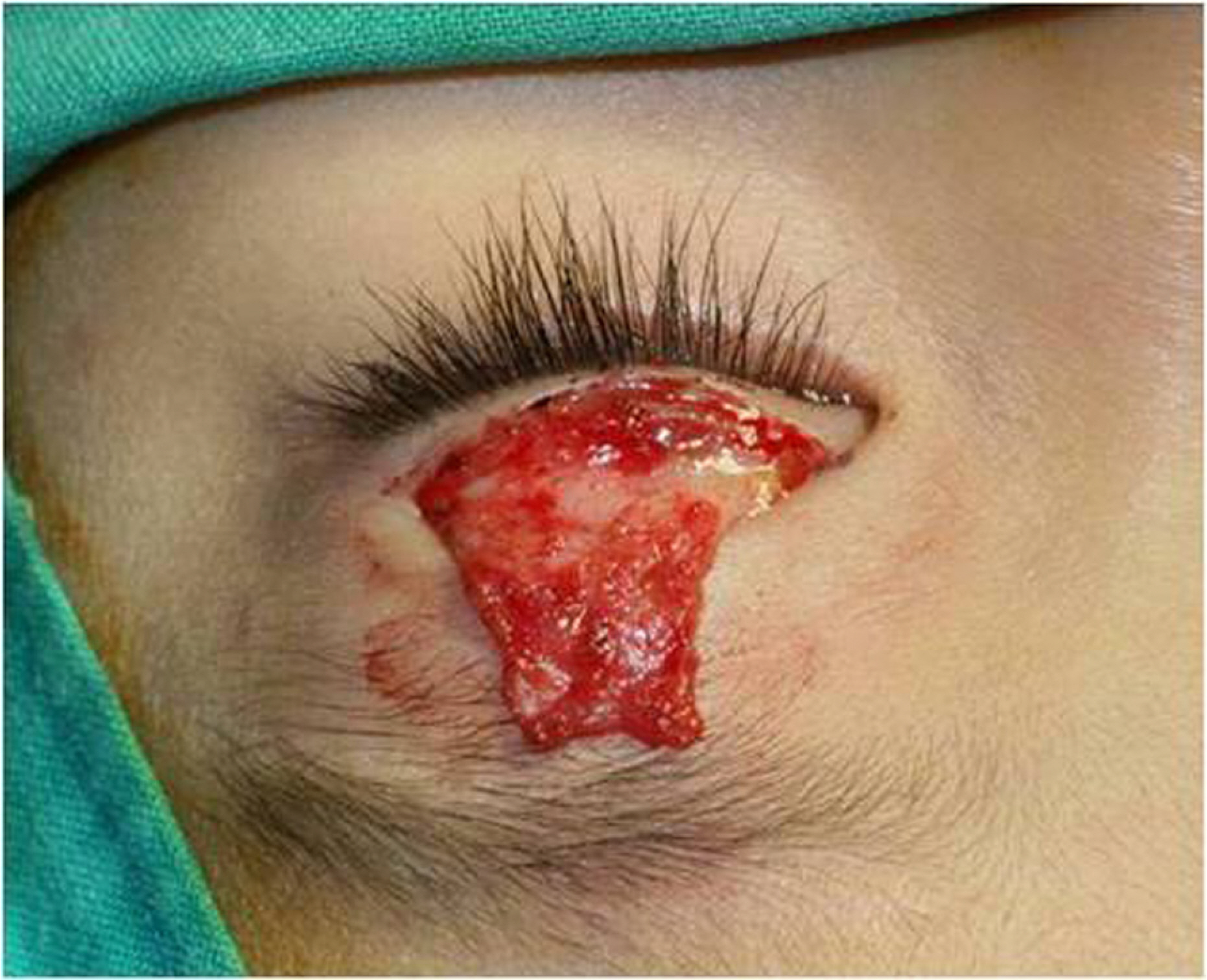J Korean Ophthalmol Soc.
2010 Feb;51(2):282-285. 10.3341/jkos.2010.51.2.282.
Use of the Levator Muscle as a Frontalis Sling in Monocular Elevation Deficiency
- Affiliations
-
- 1Department of Ophthalmology, Yonsei University College of Medicine, Seoul, Korea.
- 2Department of Ophthalmology, National Health Insurance Corporation Ilsan Hospital, Goyang, Korea. khyeye@paran.com
- KMID: 2213153
- DOI: http://doi.org/10.3341/jkos.2010.51.2.282
Abstract
- PURPOSE
For the correction of ptosis in monocular elevation deficiency (MED) patients, levator resection or frontalis sling operation with various materials has been used. The authors present a case of a monocular elevation deficiency patient who was treated for ptosis using the levator muscle as a frontalis sling.
CASE SUMMARY
A six-year-old male patient with left monocular elevation deficiency underwent a frontalis sling operation using a levator muscle. The patient had received left inferior rectus recession, left medial rectus resection and left lateral rectus recession with transposition. An upper eyelid skin crease incision was made, and the anterior surface of the levator muscle was exposed as far as the Whitnall ligament. A levator muscle flap was then formed from aponeurosis by incising the full width of the levator horizontally, just below the Whitnall ligament and anchored to the frontalis muscle. The surgical result was satisfactory as the preoperative MRD1 was 0.5 mm and the postoperative MRD1 was 2.5 mm. There were no complications such as keratitis or wound problems.
CONCLUSIONS
The levator muscle flap can be an effective frontalis suspension material to correct ptosis in an MED patient with poor levator function.
Figure
Reference
-
References
1. Cooper EL, Greenspan J. Operation for double elevator paralysis. J Pediatr Ophthalmol Strabismus. 1971; 8:8–14.
Article2. Jampel RS, Fells P. Monocular elevation paresis caused by a central nervous system lesion. Arch Ophthalmol. 1968; 80:45–57.
Article3. Wright KW, Liu GY, Murphree AL, et al. Double elevator palsy, ptosis and jaw-winking. Am Orthoptic J. 1989; 39:143–50.4. Callahan MA. Surgically mismanaged ptosis associated with double elevator palsy. Arch Ophthalmol. 1981; 99:108–12.
Article5. Kim J-Y, Kim YD. Frontalis suspension using autogenous fascia lata. J Korean Ophthalmol Soc. 2004; 45:1799–806.6. Crawford JS. Repair of ptosis using frontalis muscle and fascia lata: A 20-year review. Ophtahlmic Surg. 1977; 8:31–40.7. White JW. Paralysis of the superior rectus and inferior oblique muscle of the same eye. Arch Ophthalmol. 1942; 27:336–71.8. McNeer KW, Jampolsky A. Double elevator palsy caused by anomalous insertion of the inferior rectus. Am J Ophthalmol. 1965; 59:317–9.9. Ford CS, Schwartze GM, Weaver RG, Troost BT. Monocular elevation paresis caused by an ipsilateral lesion. Neurology. 1984; 34:1264–7.
Article10. Munoz M, Page LK. Acquired double elevator palsy in a child with pineocytoma. Am J Ophthalmol. 1994; 118:810–1.11. Ibrahim HA. Use of the levator muscle as a frontalis sling. aberrations Plast Reconstr Surg. 2007; 23:376–80.
Article12. Kersten RC, Bernardini FP, Khouri L, et al. Unilateral frontalis sling for the surgical correction of unilateral poor function ptosis. Ophthal Plast Reconstr Surg. 2005; 21:412–6.13. Lee SY, Kim KS. A case of double elevator palsy associated with blepharoptosis. J Korean Ophthalmol Soc. 1995; 36:1582–6.14. Betharia SM, Kumar S. Levator sling for Marcus Gunn ptosis. Br J Ophthalmol. 1987; 71:685–9.
Article15. Khwarg SI, Tarbet KJ, Dortzbach RK, Lucarelli MJ. Management of moderate to severe Marcus-Gunn jaw winking ptosis. aberrationsogy. 1999; 106:1191–6.
- Full Text Links
- Actions
-
Cited
- CITED
-
- Close
- Share
- Similar articles
-
- Outcomes of Anterior Levator Resection and Frontalis Sling in Congenital Ptosis with Poor Levator Function
- The Frontalis Muscle Transposition in Severe Congenital Ptosis
- A Clinical Report on the Use of Autogenous Levator Muscle Transposition and Bilateral Frontalis Sling for Ptotic lid in Neurogenic Blepharo-ptosis
- Comparison of Frontalis Sling and Levator Resection for Recurrence after Frontalis Sling in Congenital Ptosis
- The Operation of Unaffected Normal Eye in Unilateral Ptosis



